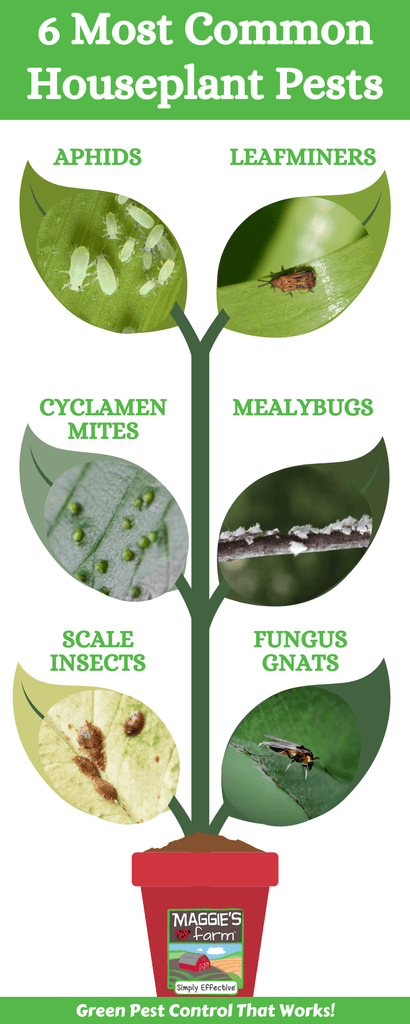If you’re looking for natural ways to decorate your home, ornamental plants and flowers are a great option. Unfortunately, bugs like to make these plants their home and food source. When this happens, they can weaken and damage your plants. We’ve made a list of the most common houseplant pests to help you keep your plants safe.
1. Aphids

These tiny bugs are infamous for targeting plants in your home and garden. Aphids are pear-shaped bugs that grow to 1/8ʺ in length. They have a soft body, and only a few will develop wings. They come in a variety of colors including green, yellow, red, black, and brown. These bugs cluster together on plants to feed on plant sap. Their feeding often leads to curling, wilting, or yellowing of leaves. They secrete honeydew, which can lead to mold growth. They also are known to spread plant diseases. Aphids multiply and travel quickly, which can lead to large infestations.
2. Fungus Gnats
If your plants aren’t looking as healthy as they should, fungus gnats could be the cause. Adult fungus gnats are grayish-black bugs that grow up to 1/8ʺ. They have long legs and clear wings. While you are most likely to notice adult fungus gnats, their larvae are more harmful to plants. Fungus gnat larvae have a white body with a black head. They are about 1/4ʺ in length. They like to live in rich, damp soil and feed on plant roots. This causes poor growth, yellowing, and wilting. These bugs are most likely to target African violets, carnations, geraniums, and poinsettias. Make sure you don’t overwater your plants to avoid attracting fungus gnats.
3. Mealybugs

Mealybugs enjoy feeding on your plants. Like aphids, mealybugs can be found on indoor and outdoor plants. These oval-shaped bugs range in size from 1/10ʺ– 1/4ʺ. They have a soft, pink body and lack wings. Mealybugs have a waxy coating, which gives them a fuzzy appearance. They hang out on the leaves, stems, and fruit of plants. They can sometimes be tricky to spot because they like to hide underneath leaves and flower petals. When they feed on plant sap, they weaken the plant. This leads to yellowing and curling of the leaves. They also secrete sticky honeydew that promotes mold growth. Once they find a food source, they won’t leave.
4. Leafminers
Leafminers are another pest that could target your houseplants. Adult leafminers aren’t likely to cause damage to plants, but their larvae can. Leafminer larvae are wormlike, green or yellow bugs that grow up to 1/3ʺ in length. Larvae create tunnels in leaves where they live and feed on the plant. These tunnels result in white lines or blotches on the leaves and can hinder plant growth. You may notice adult leafminers flying near the plant. Adults are about 1/10ʺ and have a black or gray body with yellow stripes. Leafminers target a wide variety of plants and trees including ornamental flowers.
5. Scale Insects

If you’re dealing with yellowing leaves, you’ll want to check for scale insects. These bugs often appear as small bumps on plants. There are two types of scale insects—hard and soft. Hard scale insects are immobile and live under a hard covering. This oval-shaped shell is about 1/8ʺ long and isn’t attached to the insect. Soft scale insects have a waxy film that’s part of their body. It grows to about 1/2ʺ long. Hard scale insects won’t move after settling into a spot; however, soft scale insects can move small distances. Scale insects feed on plant sap, which weakens the plant. Not only will leaves be discolored, the plant may also have growth problems.
6. Cyclamen Mites
Cyclamen mites are great at hiding on plants. These bugs are tiny—less than 1/64ʺ—and slightly transparent. They like to stay inside the folds of leaves and other enclosed parts of a flower. This, combined with their green or brown coloring, can make it difficult to spot these mites. When mites have found a hiding spot, they will pierce the plants and suck sap. Plant damage is usually spotted before the actual mite. Cyclamen mites can cause plants to have blotchy, wrinkled leaves. Discoloration and withering can also be a problem. These mites prefer areas that are warm and humid. They often target African violets, chrysanthemums, and petunias.

Nobody wants bugs in their home, especially when they can harm your houseplants. It’s important to check for warning signs to keep your plants healthy. If pests are attacking your houseplants, we want to help! Check out our Maggie’s Farm Simply Effective™ 3-in-1 Garden Spray for a more environmentally and family-friendly solution.

I’ve became a plant parent a year ago, I ended up getting spider mites on my rose bush, so I went to my local big box store and found Maggie’s Organic Garden Spray, Let me just say, I’ll not buy anything different. I treat all my indoor plants with this also. Great product and great article, love to see more from Maggie’s!